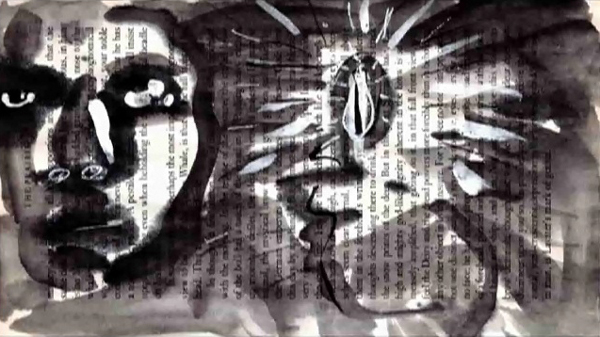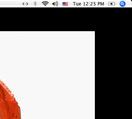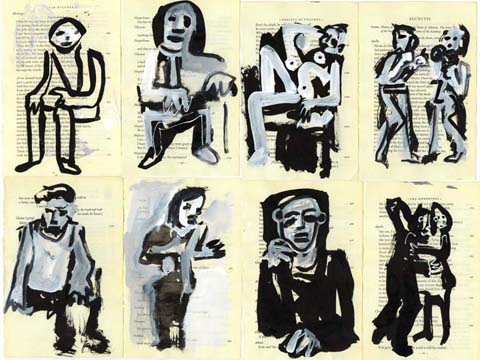Via Ron Silliman, an interesting profile of Edmund Skellings, poet laureate of Florida since 1980 and newly appointed professor of humanities at Florida Tech. A New Englander, Skellings started off as a poet in the Robert Frost mould, and even studied under Frost at the University of Iowa in the late 50s. Around that time, however, he started experimenting with sound recordings on magnetic tape and later published a book of poems, Duels and Duets, whose covers were two vinyl recordings of Skellings voice. In 1978, Skellings discovered computers and thence embarked on a long career as an electro-poetic experimenter, combining audio recordings with digital animations of imagery and text, all the while retaining a poetic style as accessible and unadorned as Frost’s (or so the Florida Today article asserts). You can view some of digital creations on his web site. Skellings isn’t necessarily the electronic poet (or animator) for me, but his life is an interesting case study of literary and technological flux.
Category Archives: animation
read this
An interesting experiment on Vimeo. See what’s going on?
Via IT IN place.
orson whales in high def
Alex Itin has posted a new “print” of his mind-blowing Moby-Dick animation, “Orson Whales,” on Vimeo, which now offers gorgeous high definition streaming. Click the image below.

poem for no one
Just came across something lovely. Video for “Jed’s Other Poem (Beautiful Ground)” by the now disbanded Grandaddy from their great album The Sophtware Slump (2000). Jed is a character who weaves in and out of the album, a forlorn humanoid robot made of junk parts who eventually dies, leaving behind a few mournful poems.
Creator Stewart Smith: “I programmed this entirely in Applesoft BASIC on a vintage 1979 Apple ][+ with 48K of RAM — a computer so old it has no hard drive, mouse up/down arrow keys, and only types in capitals. First open-source music video, code available on website. Cinematography by Jeff Bernier.” A nice detail of the story is that this was originally a fan vid but was eventually adopted as the “official” video for the song.
Thanks to Alex Itin for the link!
cinematic reading
Random House Canada underwrote a series of short videos riffing on Douglas Coupland’s new novel The Gum Thief produced by the slick Toronto studio Crush Inc. These were forwarded to me by Alex Itin, who described watching them as a kind of “cinematic reading.” Watch, you’ll see what he means. There are three basic storylines, each consisting of three clips. This one, from the “Glove Pond” sequence, is particularly clever in its use of old magazines:
All the videos are available here at Crush Inc. Or on Coupland’s YouTube page.
the noble rot
Observe these gorgeous Rorshach mold blots blooming their way across the pages of old books. A video by Ben Hemmendinger, found on Vimeo.
The piece is titled “Edelfäule,” which a little Googling reveals to be German for “noble rot” -? “referring to BOTRYTIS CINEREA, the beneficial mold responsible for the TROCKENBEERENAUSLESE wines.” (Epicurious Wine Dictionary).
Thanks Alex for the link!
moby-dick animated
Alex Itin has done it again. Here it is: “Orson Whales,” an intertextual fantasia on Moby-Dick and Orson Welles set to the savage drums of John Bonham. Each frame is a page of this edition of the Melville text, painted and photographed and strung together in iMovie.
What you’re seeing is the entire book (actually two full copies – Alex can only paint on one side of each page because of bleed-through, so to get the whole text he had to double up). Here’s some of it stacked up in the studio (this is months of work):

The soundtrack is detritus gathered from web searches, a hunt for the white whale through a sea of tangents – appropriate, really, for the great book, which is so notoriously (and gloriously) tangential.
Alex: “The soundtrack is built from searching “moby dick” on You Tube (I was looking for Orson’s Preacher from the Huston film from the fifties) I couldn’t find the preacher, but did find tons of Led Zep and drummers doing Bonzo and a little Orson……. makes for a nice Melville in the end.”
Also check out his animation, same technique, of Ulysses. Bravo, Alex! (and happy birthday)!
incredible ulysses animation
Alex Itin, our ever-astonishing resident artist/blogger, has been playing around with viral video outlets like YouTube, Google Video, Vimeo and MySpace, embedding movies on his site and re-mounting some of his older film projects, which were previously too cumbersome for quick-and-dirty webcasting.
The following (originally posted here) is a short animated riff on Joyce’s Ulysses, in which actual pages from the book serve as frames, with figures painted over text. Joyce himself provides the vocal track. The drawings and sound apparently were not synched, which at times is hard to believe since they can be strikingly consonant.
NSFW!
Alex has been painting on books for years, exploring a kind of palimpsest style — old, yellowed texts or roadmaps like the walls of a decaying city, against which sinewy, calligraphic figures move. Some of his mixed media works, like Odd City (re-mounted recently on the blog as an animated GIF) have involved the flipping of pages, which yields a crude filmic effect. “You Cities” works on a grander scale, opening up new dimensions on the 2-D page. You find yourself pulled into a visual stream of consciousness.
subtitles and the future of reading
After enduring a weeks-long PR pummeling for its dealings in China, Google is hard at work to improve its image in the world, racking up some points for good after slipping briefly into evil. Recently they launched Google.org: a website for the Google Foundation, the corporation’s philanthropic arm and central office of evil mitigation. Paying a visit to the site, the disillusioned among us will be pleased to find that the foundation is already sponsoring a handful of worthy initiatives, along with a grants program that donates free web advertising to nonprofit organizations. And just in case we were concerned that Google might not apply its techno-capitalist wizardry to altruism as zealously as to making profit, they just announced today they’ve named a new director for the foundation by the name of — no joke — Dr. Brilliant. So it seems the world is in capable hands.
One project in particular caught my eye in light of recent discussions about screen-based reading and genre-blending visions of the book. Planet Read is an organization that promotes literacy in India through Same Language Subtitling — a simple but apparently effective technique for building basic reading skills, taking popular visual entertainment like Bollywood movies and adding subtitles in English and Hindi along the bottom of the screen. A number of samples (sadly no Bollywood, just videos or photo montages set to Indian folk songs) can be found on Google Video. Here’s one that I particularly liked:
Watching the video — managing the interplay between moving text and moving pictures — I began to wonder whether there are possibly some clues to be mined here about the future of reading. Yes, Planet Read is designed first and foremost to train basic alphabetic literacy, turning a captive audience into a captive classroom. But in doing so, might it not also be nurturing another kind of literacy?
The problem with contemporary discussions about the future of the book is that they are mired — for cultural and economic reasons — in a highly inflexible conception of what a book can be. People who grew up with print tend to assume that going digital is simply a matter of switching containers (with a few enhancements thrown in the mix), failing to consider how the actual content of books might change, or how the act of reading — which increasingly takes place in a dyanamic visual context — may eventually demand a more dynamic kind of text.
Blurring the lines between text and visual media naturally makes us uneasy because it points to a future that quite literally (for us dinosaurs at least) could be unreadable. But kids growing up today, in India or here in the States, are already highly accustomed to reading in screen-based environments, and so they probably have a somewhat different idea of what reading is. For them, text is likely just one ingredient in a complex combinatory medium.
Another example: Nochnoi Dozor (translated “Night Watch”) is a film that has widely been credited as the first Russian blockbuster of the post-Soviet era — an adrenaline-pumping, special effects-infused, sci-fi vampire epic made entirely by Russians, on Russian soil and on Russian themes (it’s based on a popular trilogy of novels). When it was released about a year and a half ago it shattered domestic box office records previously held by Western hits like Titanic and Lord of the Rings. Just about a month ago, the sequel “Day Watch” shattered the records set by “Night Watch.”

While highly derivative of western action movies, Nochnoi Dozor is moody, raucous and darkly gorgeous, giving a good, gritty feel of contemporary Moscow. Its plot grows rickety in places, and sometimes things are downright incomprehensible (even, I’m told, with fluent Russian), so I’m skeptical about its prospects on this side of the globe. But goshdarnit, Russians can’t seem to get enough of it — so in an effort to lure American audiences over to this uniquely Russian gothic thriller, start building a brand out of the projected trilogy (and presumably pave the way for the eventual crossover to Hollywood of director Timur Bekmambetov), Fox Searchlight just last week rolled the film out in the U.S. on a very limited release.
What could this possibly have to do with the future of reading? Well, naturally the film is subtitled, and we all know how subtitles are the kiss of death for a film in the U.S. market (Passion of the Christ notwithstanding). But the marketers at Fox are trying something new with Nochnoi Dozor. No, they weren’t foolish enough to dub it, which would have robbed the film of the scratchy, smoke-scarred Moscow voices that give it so much of its texture. What they’ve done is played with the subtitles themselves, making them more active and responsive to the action in the film (sounds like some Flash programmer had a field day…). Here’s a description from an article in the NY Times (unfortunately now behind pay wall):
…[the words] change color and position on the screen, simulate dripping blood, stutter in emulation of a fearful query, or dissolve into red vapor to emulate a character’s gasping breaths.
And this from Anthony Lane’s review in the latest New Yorker:
…the subtitles, for instance, are the best I have encountered. Far from palely loitering at the foot of the screen, they lurk in odd corners of the frame and, at one point, glow scarlet and then spool away, like blood in water. I trust that this will start a technical trend and that, from here on, no respectable French actress will dream of removing her clothes unless at least three lines of dialogue can be made to unwind across her midriff.
It might seem strange to think of subtitling of foreign films as a harbinger of future reading practices. But then, with the increasing popularity of Asian cinema, and continued cross-pollination between comics and film, it’s not crazy to suspect that we’ll be seeing more of this kind of textual-visual fusion in the future.
Most significant is the idea that the text can itself be an actor in a perfomance: a frontier that has only barely been explored — though typography enthusiasts will likely pillory me for saying so.
artist as blogger
last spring we invited Alex Itin to be our first artist-in-residence at the institute. i first met Alex in the fall of 2000, during an art festival in Dumbo. he was set-up in a gallery painting portraits on pages of used books. i quite liked the paintings and got the perverse idea that it would be interesting to encourage someone who was using books in this way to work on an electronic book. i was working at Night Kitchen at the time. we had just released the beta version of TK3, the software we made for authoring and reading media rich electronic books. we lent Alex a Mac and he made his first electronic piece, Zoodoo – a series of paintings done on paperback pages which accompanied a beautiful Amiri Baraka poem. (if you first install the free TK3 Reader you can download Zoodoo from this page.) Alex kept experimenting and over time began animating the surface of his scanned-in paintings. while there has been a long history of filmmakers who painted on the surface of film, Alex was perhaps one of the first painters to integrate video into his paintings.
 |  | |
 |  | |
| From “Self Portait” by Alex Itin | ||
as a condition of his artist-in-residency we asked Alex to keep a blog in which we hoped he would write about his work as he did it. we were amazed after a few days to realize that alex was beginning to use the blog not as a way to talk about his work, but rather it was just another venue for his work. at first Alex posted paintings, drawings and photos sometimes with a text commentary. after a while he started to include animated gifs and sound. although the artist-in-residency ended almost a year ago, alex has been keeping up the blog. in fact, he’s been on a creative tear the past few weeks. check out the last two entries — the “thousand year crane” (be sure to start the music track) and the Chinese new year tree.
(disclaimer: i’ve been collecting Alex’s work for six years now, so my interest in his success is not purely altruistic)

